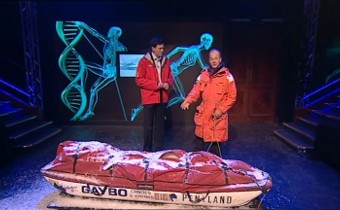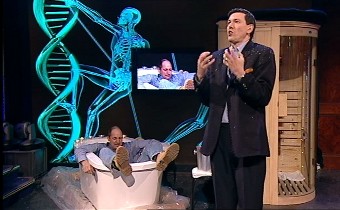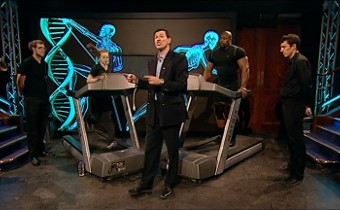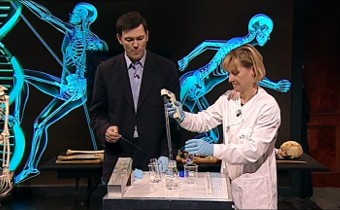
Hugh Montgomery takes us on a journey to see how the human body has evolved over 4 billion years to become the extraordinary and complex machine that it is today. He also visits some of the most extreme environments on the planet to see how our bodies cope with being pushed to their absolute limit and welcomes guests into the studio who give first-hand experience of making it against the odds.

Life on Earth began 4 billion years ago, but humans appeared only 130,000 years ago. With such a long period in ‘research and development’, it isn’t surprising that the ‘human machine’ is so amazingly complex - far more complex than any state-of-the-art racing car.
But just like a petrol engine, humans use oxygen to burn fuels and release the energy which powers every function in every cell. So how do we get the oxygen from the air to the cell? This first programme will find out how this happens, even at the top of the world.
We shall look at the airways that carry the oxygen, and the rib-and-muscle bellows which drive air through them.
We shall look at the lung, how it passes the oxygen on to the blood, and the cells there which snatch and hold that oxygen. We shall find out how the heart pumps them around the body, and examine the blood vessels that carry them.
Finally, we shall hear from mountaineers who have climbed Mt Everest, where there is three-times less oxygen than at sea level, and see what happens to their bodies when they struggle to stand at the very top of the world.

In programme one, we discussed how humans take up oxygen and deliver it to cells, where it is used to burn fuels- fuels that come in our food. But what are these fuels? How do we get them from the dinner plate to the cell? And what other things are there in the food apart from fuel?
In this programme, we’ll explore these issues.
We’ll also find out what happens to the fuel and oxygen in a cell- and how food is converted into an ‘energy currency’ to be spent in different ways around the body.
We’ll find out what happens when we eat or drink more than we need.
But we’ll also find out what happens when we are starved of food, or deprived of water.
What happens when we become dehydrated? Does it matter? Can the kidneys cope? How long can someone survive without any fluids?
And what happens if we miss some key bits of food out of our diet? What is the body’s response if we are starved of food altogether? How long can it cope?
Finally, we’ll consider castaways, and talk to some real-life survivors, finding out how they survived the lack of food and water.

Humans live in extraordinary places - from the middle of the Sahara desert to the frozen wastes of Alaska. Take a snake to the North Pole, and it will stop moving in minutes. Take a cat to the desert and it can be dead in hours. So how can humans survive such extremes? And could you?
We’ve learned how the body burns fuel using oxygen and creates an ‘energy currency’. Here, we’ll learn how this creates heat. We’ll find out that some of the ‘work’ done when the energy currency is spent can keep you warm. We’ll discover whether shivering really works, whether a ‘hot meal’ really makes a difference and whether mothers are right when they say that you should ‘wear a hat on a cold day’. We’ll also find where blood is diverted when it gets cold.
But what about when it is too hot? Where does the blood go then? What is sweat and how does it work? And why do dogs pant, and humans not?
Finally, we’ll meet some survivors of the very coldest places in the world, and also the very hottest. What are the limits to survival? And how close did they get to finding out?

When the shark is honing in, you must swim for your life. When the soldier faces enemy guns, he must run to survive. Or sometimes, stand and fight.
Such physical work involves burning a huge amount of energy. So how does the body increase that energy delivery, all of a sudden? What happens to the heart, lungs and blood vessels? How is the energy used?
Today, we shall answer some of these questions, looking at the amazing high-performance all-terrain vehicle that is the human body. We’ll find out what the skeleton is made of, and how muscles attach to move it. We’ll find out what those muscles are made of, and how they create force. And we’ll also find out how they are controlled- the ‘computer’ in our skulls, and the wiring that carries the ‘messages to move’.
Are all muscles the same or not? Why is it that one person can sprint well, and another is better at running a long distance?
We’ll make an athlete exercise to exhaustion to find out. And then we’ll talk to someone whose ability to just keep on going determined whether he’d live… or die.

So the human body is an amazing machine, equipped to take in fuel and oxygen, convert it into an energy currency, and spend this in cells throughout the body to keep us alive. We can survive severe shortages of oxygen, food and water, and cope with extreme heat and cold. We can run fast when we have to, and can ‘keep going’ for amazing distances.
But are we all the same? Faced with the same perils, would we all cope just as well? And if not, is it down to luck? To ‘being tough’? Or is there such a thing as the will to live?
Today, we’ll look at our genes- and how they make us different. How much of the way we are is ‘nature’ and how much ‘nurture’? And do whether they influence our chances of survival. Can they protect us from infections, or help us survive them? Allow us to run further and faster. Or even make us feel less (or more) pain?
Finally, we’ll talk to some amazing survivors, and find out how much of this survival was down to training and preparation, to being tough, to ‘will to live’, to their genes…or to good old-fashioned luck.
| Presenter | Hugh Montgomery |
| Executive Producer | David Dugan |
| Director | David Coleman |
| Producer | Martin Gorst |
| Production Manager | Sil Mcilveen |
| Production Coordinator | Clare Labrosse |
| Music | John Cleasby |